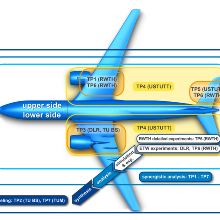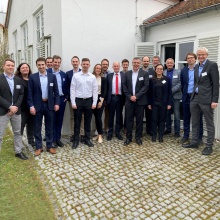The aerodynamics of transport aircraft at the borders of the flight envelope are characterized by complex interactions and non-linear, transient aerodynamics. The resulting physical mechanisms are not fully understood and a prediction of aerodynamic properties, transient loads and aeroelastic behavior is a major challenge and requires the use of complex numerical models. Scale resolving methods are hardly validated for this application and need to be extended for higher Reynolds numbers in order to perform high-resolution simulations taking into account all physical effects. Apart from a lack of high resolution flow field measurements to study the underlying physical mechanisms, there are few scientifically usable and sufficiently detailed measurements of complete configurations for high, flight-relevant Reynolds numbers.
The main goals of the research group 2895 are the comprehensive investigation of the unresolved physical issues in the high-speed stall of transport aircraft, the extension and qualification of numerical methods for this application and the modelling of unsteady flow and nonlinear aerodynamics with reduced order models. The local physical mechanisms and interactions must be understood to achieve a description of the aerodynamic effects for the complete configuration.
The knowledge gain will be achieved by coordinated numerical and experimental studies of the flow physics in different parts of the flow field combined with corresponding investigations on a full aircraft configuration. The research group, which is organized in seven subprojects, carries out detailed studies on the buffet on the upper side of the wing, the development of the separated wake and its interaction with the tail plane. These studies will be carried out on the Airbus XRF-1 transport aircraft configuration, in which an ultra-high bypass nacelle will be integrated to study engine influences and local interactions. In order to enable measurements up to flight-relevant Reynolds numbers, the experiments will be conducted in the cryogenic wind tunnel ETW with funding from the HGF and DLR. The resulting numerical and experimental data base will be used for modelling and derivation of reduced order models and for flow physics studies. In addition, the fundamental flow phenomena will be studied numerically and experimentally by FOR 2895 on a generic tandem wing configuration at reduced Reynolds number, which allows spatially higher resolved measurements in relation to the relevant scales of the boundary layers.





